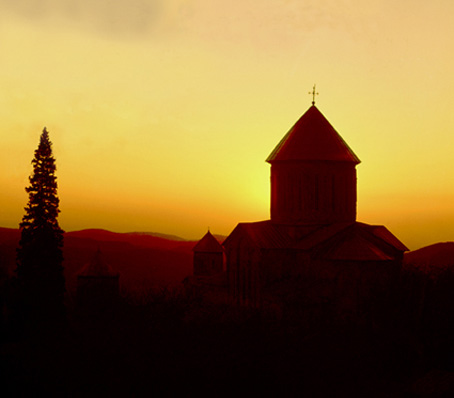The plot for the photographic poem “The Wheel of Changeful Fortune” was provided by “Davitiani” itself. The poem tells the story of Kartli and Kakheti – two prominent regions in Georgia. It was there that I focused my attention in order to illustrate the subject of the poem and to portray an image of Georgia – freedom loving, proud, suffering from the voluntarism and animosity of its rulers, their lack of unity and never ending feudal conflicts.
Just as Guramishvili’s story is about his Motherland, the photographic lineup in the album starts at Guramishvili’s home – his family property in the village of Saguramo. The plot of “Davitiani” itself suggested the style, color, lighting, as well as the timing of the photo shoots. The fall sun of October proved excellent for bringing out live nature and served as a color theme for the future book. Both the time of year and nature itself supported the theme.
Thus started the long and laborious but at the same time interesting and rewarding project. It became a four-year trip into the history of Georgia, Russia, and Ukraine. Tens of thousands kilometers were left behind despite changing seasons and weather conditions. I collected materials for the photographic poem frame by frame in the Poltava region of Ukraine, in Moscow, St. Petersburg, Vladimir, Saratov and Nizhniy Novgorod, the wetlands of Astrakhan and deserts of Kalmykia and Kaspiy, mountains of the North Caucasus and Georgia. I was completely immersed into the subject and came by unbelievable situations and adventures as it evolved.
The album “A Song of Georgia” is an artistic photo composition and the fruit of ten years of hard work on the Georgian soil. The “Song” did not come easy. It took me ten years to learn the country, its rich culture, customs, and the way of life in sufficient detail, as well as to meet many prominent people of the land in order to portray it and convey the image in art.
Nowadays, “Davitiani”, “The Wheel of Changeful Fortune” and “A Song of Georgia” are in demand more than ever because the serve as a warning and reminder of the past.
Presently, I have completed a new revised and improved edition of “The Wheel of Changeful Fortune” featuring a new artistic design and taking advantage of modern publishing technologies.
My work on the legacy of David Guramishvili brought me to the Temple of Gelati, a unique piece of the 12-18th century Georgian architecture. The Temple adorns the surrounding mountain ridges for many a century. The monastery strikes one with its monumental architecture, beautiful frescos and mosaics. It was build under King David the Builder and was a focal point of the Georgian culture and a store of knowledge. It served as a burial vault of Georgian kings and is a pride of Georgia.
Photo shoots required much preparation. The main temple did not have electric lighting. A tall scaffolding had to be build in order to gain access to the unique mosaics of the 12th century and ancient frescos in order to avoid any undesired distortions or the resulting images.
Many residents in the neighborhood participated in the effort. It was December which in Georgia is considered late fall or early winter. Because of the slippery mountain roads, we barely managed to tractor up enough beams for the scaffolding. There were many technical issues, as well – it took a while to put the lighting in place because it required an extra long (over 1 km) electric cable and the voltage it provided proved insufficient for the powerful halogen lamps; the frame of the tall wooden scaffolding turned out to be unstable and dangerous to use.
Finally, there came a moment Gelati has not seen in all nine centuries of its existence. Instantaneously, the entire interior of the Nativity of the Mother of God Cathedral was filled with bright electric light and erupted with applauses from the tourists admiring the ancient fresco masters for their beautiful art.
“Gelati” was first and remains the only album ever published on the outstanding piece of the Georgian culture of the 12-18th centuries. It was still in print when my thoughts already turned to Svanetia.
“You are a speck of sand in the Universe,
You are as kind and stern as the world itself,
With your undying beauty
Pleasing me from high above the clouds”
Written by Revaz Margiani, a Georgian and Svan poet, these lines accompany the artistic lineup in the photographic album “Under the Sky of Svanetia”. It was pure pleasure to work in this beautiful mountainous land of Georgia. Svanetia is tall mountain peaks always covered by never melting snow, swift and tumultuous rivers, succulent pastures, thick emerald forests on mountain hills, and, of course, the people – proud, industrious and affable Svans.

